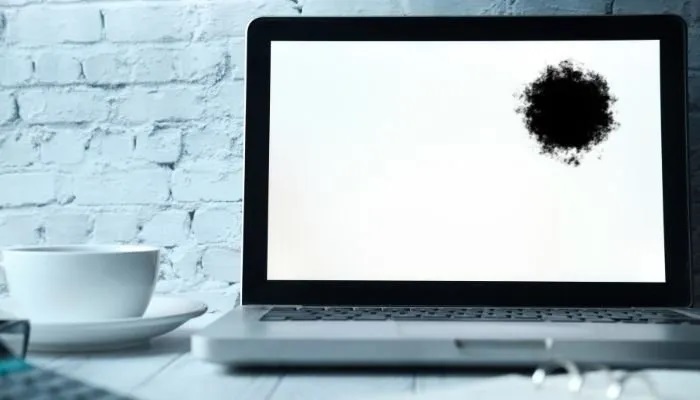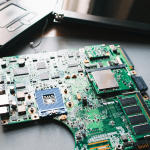Is it time to replace your dark computer screen? If so, you need to fix the problem before replacing your computer.
This article will show you how to repair your computer screen and fix the black area — all by yourself!
I’ll include a list of resources you can utilize to repair your computer screen and get rid of the black area.
I’ve also included a couple of outside options so you can choose what works best for you.
What causes black spots on Laptop Screen?
Contents
When the power is turned off, black spots may remain visible.
The most common cause for this type of screen issue is the backlight.
Faucet water, spilled drinks, and humidity can build up on the inside of the display case and get trapped behind the screen.
This can cause discoloration in the screen, which is usually described as “dirty screen syndrome.” All these factors are a result of exposure to moisture.
The response of LCD monitors to these factors varies depending on the brand of the monitors, and the sensitivity of the individuals operating them.
This transistor causes the pixels to light up, but then not get enough light.
Without light, the pixels will remain in “off” state. This phenomenon can cause pixels on your screen to turn black.
As a result, the laptop screen cannot display anything.
Black spots can also result from a damaged display filter, which gives the pixels a black color. The pixels will stay in this state until they can be repaired or replaced.
Moist or Dry Air
Humidity and dry air make laptops more susceptible to viruses and spyware.
Unlike a moist environment, which causes condensation and short circuits, a dryer environment allows viruses and spyware to spread. Viruses and spyware are carried through the air.
If this environment dries out, the threats can spread faster.
We use a moist towel more frequently than not for cleaning.
It may result in conductivity loss, condensation, short circuits, and corrosion of components, as well as more severe long-term effects.
It may result in conductivity loss, condensation, short circuits, and corrosion of components, as well as more severe long-term effects.
To prevent this, you should always keep your devices in a dry, well-lit environment.
Manufacturing Defects
Mistakes happen throughout the manufacture of a computer. Some of them may be evident as black spots. While other mistakes may go unnoticed.
There might be a scratch when it is carrying the enclosed box.
These precautions are taken to prevent laptop screens from breaking during the transportation process.
The spacing between each pixel on a display screen is called pixel pitch.
If the gap is too small, it will cause the pixels to appear blurry, and this will make it look dull.
Black spots on laptop displays can be caused due to various factors including wrong positioning of the display panels, inability of the laptop to absorb heat, or malfunctioning hardware components.
These defects affect the display of the laptop. If the black spots are not rectified, the displays can only become worse.
Physical Damage
Physical damage to displays, such as a forceful hit or a drop, causes the pixels to break, creating small black spots.
However, these spots are purely cosmetic, and do not degrade the user experience.
The shattered pixels first appear in small clusters and gradually spread beyond the original focus point.
Many laptop owners do not realize that physical damage can cause damage to the LCD screen.
The most prominent and broad symptom of physical damage to laptop screens is the presence of black spots.
These spots can take various shapes, including star shapes, circular blobs, or full blown squares.
Some spots appear small and insignificant at first, while others develop into large and jagged patterns.
In most cases, physical damage to laptop screens causes permanent damage and renders the system unusable.
High Temperature
If everything else is working correctly, a high temperature may be the cause of those black spots.
Heat is a normal process that computers must endure.
They are more susceptible to damage from high temperatures. These are usually black spots that happen on laptops and desktops.
It may have the opposite effect on some parts, such as increasing the speed of CPU and hard disk.
Black spots on laptop screens might be caused by overheating chips or motherboard. They are easily visible as white to dark grey areas.
As a result, inappropriate functionality occurs, such as slow or incomplete loading.
If temperatures are fine, then nothing of a bad smell happens, and the fan runs as normal.
If temperatures aren’t fine, then black spots appear on the screen, smoke is coming from the device, and a loud constant beeping sound is heard.
Dust and Dirt
Aside from that, dust and dirt accumulation is also a contributing factor in the deterioration of our laptop’s display.
Thus, we must regularly clean our laptop screens in order to help preserve their condition.
It accumulates on our laptop displays because the screens don’t have back lighting.
As dust and dirt builds up, it can block the light from reaching the screen. This causes the pixels to burn out, and we get more spots.
Dust and dirt can be cleaned with an anti-static dust cover, an anti-static cloth, a microfibre cloth, or a compressed air can.
However, we should clean it more often to ensure that it does not cause us any further harm.
One common method of cleaning these blemishes is a microfiber cloth and a cleaning fluid. We will need to open the laptop’s case before carrying out the cleaning process.
Dead Pixels
The differences between stuck or corrupt pixels and dead pixels are quite obvious. Stuck or corrupted pixels, however, will still have an effect on the image, whereas dead pixels will not.
Pixels make up one visual part of every display.
In case of a laptop, the pixel density or pixel pitch refers to the number of pixels per square inch for your laptop’s screen.
The greater the pixel density, the more visually crisp the image will appear.
The pixel density may be real high sometimes.
There are three diodes that make up a pixel.
The red, green, and blue colors are sometimes called primary colors.
Each pixel is colored (or colored with more than one color), and the pixels combine with each other to form the images we see on our screens.
Small clusters of pixels can produce black spots if they are color-blind or color-blind pixels. These pixel clusters are commonly called “dead” pixels.
If all three of these are stuck or malfunctioning, they can result in a black spot.
This will not necessarily be visible at all times, but there are some screens where dead pixels are very visible.
For example, a monitor with a combination of white, black, and blue pixels will show dead pixels when the black pixels become stuck.
When this happens, the monitor will display a dark or completely white spot on the screen. If the screen is curved or if the color intensity is very low, the dead pixel may not be visible.
It’s what we refer to as a black spot on our screen.
Even if you don’t notice it, a dead pixel will have an effect on the image you are viewing. That means that the image will be slightly blurred around the edges of the pixel.
When a dead pixel is shown, it can make it look like the image is distorted.
Stuck Pixels
Another typical source of black spots on computer screens is dust accumulation, either on the screen itself or on the internal components.
This, however, doesn’t occur as often as stuck pixels.
Any pixel in an LCD or other display system that will not change will not display correct colors. This can result in a “dead” or “stuck” spot on the screen.
Pixels are programmed to change color when a picture is being drawn to the screen.
However, pixels can also be stuck if the hardware itself becomes faulty.
Stuck pixel issues can pop up during screen freezes, computer freezes, and when the computer is used for extended periods of time.
There are three different types of stuck pixels. They are segregated on four different levels of resolution.
These are, low resolution, medium resolution, high resolution, and Ultra HD. Low resolution pixels occur in the 320 pixel by 240 pixel resolution.
A pixel imprisoned is one in an endless loop of color and has no chance of escaping.
However, sometimes a pixel can become stuck even when it is still in its “normal” color. This can be caused by a malfunctioning pixel matrix or defective cabling within the laptop.
How to Fix Black Spots on Laptop Screen
Use the pixel fixer program
If you can’t use the pressure-fixing approach, there could also be dust or dirt particles on the screen.
The pixel fixer tool or app may light up the stuck or dead pixel, but not all of them.
If you’re not sure if black areas on your display are stuck or dead pixels, it’s wise to use a pixel fixer app to prevent them from becoming larger.
The application or app progressively activates all the pixels, and the black spot disappears.
After a few hits, it pops into your normal field of vision.
Fixing Stuck Pixel
Any pixel in an LCD that is unable to change color is said to be “stuck.” The hue of the lines varies from picture to photo.
Television images are known as photos.
The hue of the lines varies from picture to photo.
Television images are known as photos. A pixel’s color has been “stuck” if no modifications have been made to it.
A picture is an lCD TV signal made up of thousands of pixels, which show different shades of gray.
Many pixels may be stuck if they are displaying the wrong color (red or blue).
Fixing the stuck pixels usually does not take a long time and they are easily replaced with new ones.
If a pixel’s color does change, this is called a “metamorphosis.” In the early days of LCD technology, pixels were relatively weak and would often lose color over time.
This problem made it so that a user’s screen would appear black or gray.
Using a Humidity Sensor
Although we may not notice an increase in humidity, it can cause damage.
Our data is just priceless.
A humidity sensor, often known as hygrometer, monitors the amount of moisture in the air.
It can be placed underneath or on your equipment. A humidity sensor can provide you with important information about the climatic conditions that surround your work area.
For instance, you may want to know if the air is too dry or too moist.
Warmer air produces more moisture and this is especially true in the case of computers.
We can assure optimal humidity levels by using this sensor.
Protecting your laptop from humidity is vital.
Fixing Dead Pixel
A trapped pixel is known by every computer user and they usually try to fix it.
Usually, a dead pixel appears in the upper left corner of the screen. Fixing dead pixels is very simple.
The computer person should blink when the image screen goes black. He should press a key right away.
The computer person should blink when the image screen goes black. He should press a Key immediately.
It only takes a few moments to fix a dead pixel.
When the monitor is turned off, the dead pixels will illuminate, and then slowly fade into the darkness.
Dead ones, on the other hand, don’t cause the display to flicker.
The fix for black spots is quite simple. All that’s needed is a bit of technology and creativity.
Whether you have a dead pixel or several, you can fix it by finding the missing pixel and connecting it to the whole display.
First of all, you should take some notes in your notebook about the dead pixel’s position on the display.
With a pen, draw a line from the dead pixel to middle of your screen. Next, take a pencil and a piece of wood to steady yourself on the laptop surface.
Then, grab your tweezers and carefully grab the dead pixel.
Gently pull it down.
Don’t worry, it isn’t going to break or get damaged. With your tweezers now pointing towards the LCD, gently nudge the dead pixel until it pops back into the LCD’s frame.
If you accidentally push it too far, though, just shake the tweezers and it will slide back into the frame.
This implies that all three dead pixels are on a black level.
There are two types of dead pixels. One type is categorized as accidental, which means it happened due to mishandling.
The other type is defective and it happens when a bad component inside the chip of the laptop is defective. A dead pixel happens when there is a malfunction inside the chip.
As a result, the pixel will be illuminated even if it’s not supposed to be.
The deceased will appear as black dots on your laptop screen.
Although a small pool of light might be present on the pixel, it isn’t lit. The dead pixel is invisible to the naked eye unless it’s lit up.
Removal of Debris and Dirt
Microfiber cloths are preferable to rough towels or stiff fabric since they might damage the screen.
Avoid using solutions containing alcohol, acetone, or ammonia since these may harm the screen.
White vinegar and water in equal quantities prove to be the best cleaning solution.
It may also be fixed by cleaning it with a microfiber cloth using a 50/50 mix of vinegar and water.
Do not use ammonia, alcohol, or solvent based cleaners since they can damage your laptop.
The most effective cleaning solution is white vinegar and water in equal quantities.
Clean your laptop screen on a regular basis. If they’re deeply baked, you may need to use a soft toothbrush or soft-bristle toothbrush to get rid of them completely.
You’re ready to surf the web or watch some videos, negating the need to go to a computer service center.
The blackspots on displays can obstruct the view of the screen and make the device less functional.
Contacting Manufacturers
If the stuck or dead pixels are too large to replace, you will normally have to pay hundreds of dollars.
It has the added benefit of keeping your expensive laptop safe at home while someone else gets to fix it.
In most cases, the manufacturer will ship you a new screen to solve the problem.
Contact the manufacturer through the manufacturer’s website.
You should fill out a form and provide detailed information about the device. It is imperative that you provide the right information.
In doing this, you can increase the probability of the manufacturer handling your case quickly.
If your device is still under warranty and does not fit all of the conditions, they will fix it for you.
How to Deal With the Unexpected Pixels On Laptop Screen
If a faulty or damaged pixel on your laptop’s display screen is irrecoverable by other means, such as light material or heat, a technician may be able to repair it.
Restart the Pixel Solution app to calibrate the screen.
Make it clear to the LCD maker what you need to be able to restore the display’s lost pixels.
If you already have a warranty and satisfy repair requirements, they will be able to replace the screen.
A low resolution LCD screen displayed with a high resolution image, or loaded with constant video input, may cause damage to the pixels over time.
LCD manufacturers want to charge premium screen prices to compensate for the inherent risks of defective LCDs.
Choosing an HD LCD panel over an HD LCD panel with pixel defects allows a user to avoid visual lapses that can occur when displaying high definition content.
Also Read: How to Connect Wii U to Laptop
Conclusion
The primary causes of black spots are dust or dirt, which may prevent the disks from emitting sufficient light.
Physical damage, stuck pixels, dead pixels, and other issues may also make a black spot appear on your screen.
Dirt and debris can be removed with dusters, microfiber cloths, or compressed air.
It’s more difficult to repair stuck and dead pixels when the damage is severe.
You may have your laptop repaired if it’s under warranty and satisfies all of the conditions.
If the issue isn’t too serious and your screen is fairly new, you may be able to fix it yourself.
In certain circumstances, you may need to replace or repair the LCD screen.
To avoid black spots, adopt preventative actions such as cleaning periodically, keeping the temperature and humidity in check, and avoiding direct sunlight.




